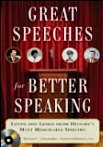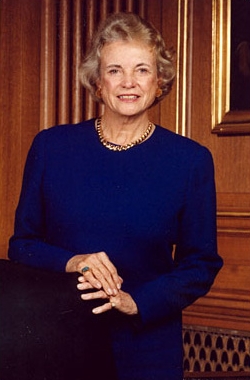[AUTHENTICITY CERTIFIED: Text version below transcribed directly from audio]
Thank you, Mayor Street, and thank all of you here today joining in this absolutely wonderful occasion, as we celebrate both our nation's birthday and the opening of the National Constitution Center here in the great city of Philadelphia. The Constitution Center and Independence Hall, together with the Liberty Bell, form a place that every American should visit. It will contribute each and every day to the reinforcement of the basic principles that bind us together as a nation and a people.
And Joe Torsella, thank you so much for your perseverance, and for reminding us today that even Supreme Court Justices make mistakes.
On May the 25th, 1787, right here in Philadelphia, a quorum of delegates from seven states met in answer to the call from the Annapolis Convention to draft what became the Constitution of the United States. The delegates unanimously selected George Washington as president of the convention. Eventually, 55 participants assembled here from 12 of the 13 states then in existence. And they met throughout that sweltering summer, behind closed doors, to offer, consider, and debate the provisions of a new national charter. Their efforts culminated on September 17th, 1787, when all 12 state delegations voted approval of the draft of our Constitution.
Now, it seems natural for Supreme Court Justices to be vitally interested in the document we spend so many of our waking hours thinking and arguing about. But it is perhaps not so natural, in the 21st century, for most other Americans to spend much time thinking about or discussing the Constitution. Although over 200 years ago most Americans hotly debated the merits of the proposed Constitution, recent polls indicate that today almost half of our citizens do not know that there are three branches of government.1,2 Thirty-five percent believe the Constitution establishes English as our national language.3
Knowledge about the ideas embodied in the Constitution and the ways in which it shapes our lives is not passed down from generation to generation through the gene pool; it must be learned anew by each generation. It's not enough simply to read or memorize the Constitution. Rather, we should try to understand the ideas that gave it life and that give it strength still today. Alexander Hamilton, one of the Framers, wrote in the first of The Federalist Papers in support of ratification of the Constitution that it was:
...reserved to the people of this country to decide...whether [we] are...capable...of establishing good government from reflection and choice, or whether [we] are forever destined to depend, for [our] political constitutions, on accident and force.4
Our citizens did reflect and make that choice, but we look around the world today and see that a great many other people have been dependent instead on "accident and force."
Much as it might seem otherwise, the Constitution is interpreted first and last by people other than judges. The judicial branch is only an intermediate step in the continuing process of making our Constitution work. The power of judicial review has been said by some to be the "cornerstone" of our constitutional law.5 Certainly an independent judiciary as provided by the Constitution has assured that the governed as well as the government are bound by the Rule of Law. But a federal court is almost never the first to ponder constitutional questions that come before it.
This means that, in the first instance, it is up to state and federal legislators and executives to decide that the laws they enact, or the actions they are about to take, are constitutional. This decision is as much their responsibility as it is the Court's. Thus, the Constitution requires all officials -- legislative, executive, federal and state -- to swear, upon taking office, that they will support the Constitution.6 Provisions of the Constitution are addressed directly to legislators and executive officials, who interpret the Constitution every day in making and applying the law.
Although the Supreme Court almost never has the first word in interpreting the Constitution, many believe it usually has the last. The Supreme Court's interpretation of the Constitution is considered binding on the states and the other branches of the federal government. But when it comes to putting the interpretation of the Constitution into practice, ultimately the Court must rely on the other branches of government.
There's a story, almost certainly apocryphal, that when the great Chief Justice John Marshall decided a very controversial case against the state of Georgia, President Andrew Jackson said: "John Marshall has made his decision, now let him enforce it."7 The story reminds us of the remarkable nature of something that we Americans usually take for granted: the willingness of the other branches of government to enforce the Court's rulings, even those with which they may disagree.
Certainly, one of the most dramatic examples of the executive branch enforcing a Supreme Court decision occurred in September [24th], 1957, when President Eisenhower ordered federal troops to Little Rock, Arkansas to ensure that, pursuant to the Court's decision in Brown versus Board of Education striking down racially segregated public schools, that nine black children would enter Little Rock Central High School. On that day, President Eisenhower addressed the nation and explained that his duty to uphold the ruling of the Supreme Court was "inescapable."
But far more remarkable and inspiring are the many more times that state or federal officials conform their operations to Court decisions with little delay or dispute. Such examples illustrate this country's devotion to the Rule of Law -- a devotion without which the protection of liberty would be impossible.
Because of the Court's role as the protector of individual rights against majority rule, at times the Court's decisions will prevail over the strong disagreement of a great many Americans. If, however, one looks at the history of the Court and of the country and the Constitution over a long period of time, the relationship appears to be more of a dialogue than a series of commands. Some Supreme Court decisions, controversial when issued, later have been strongly affirmed by the majority of Americans. Brown versus Board of Education is one of those decisions. Today, the fundamental injustice of racially segregated public schools is beyond mainstream political debate.
Now, some might find it a bit disconcerting to consider that the responsibility for protecting our Constitution rests not just on judges but on a host of others as well. The responsibility is shared by state and federal legislators considering the constitutionality of proposed laws; by litigants who must marshal the time, money, and hope to take cases to court; by political officeholders, including the President himself,8 who must see that the Court's rulings are put into practice; and by citizens, who ultimately must determine the Nation's response to each major issue. I find the system quite comforting. By spreading the responsibility to uphold the Constitution among so many, the Framers enlisted a legion of defenders for their new charter.
President Franklin Roosevelt called the Constitution a "layman's document,"9 and certainly it was not intended solely, or even primarily, for judges. While James Madison hoped the courts would be an "impenetrable bulwark" against assumptions of power by the other branches, he also believed that state legislatures would be "sure guardians of the people's liberty."10
And when Madison argued for a Bill of Rights, he knew that the strength of these freedoms would depend on how firmly they stood in the hearts of citizens. He hoped that whatever the majority might want at any given moment, they would want to uphold the Constitution more. We honor the Constitution and we honor its Framers when we run for legislative or executive office; when we write a letter to the President, to the governor, or our legislator; when a constitutional case is taken to court; or when we teach our children the meaning of the document; and even when we argue among our friends and neighbors over the application of constitutional commands to modern life.
Our Constitution is not -- and never could be -- defended only by a group of judges. One of our greatest judges, Learned Hand, understood this very well. He said, "Liberty lies in the hearts of men and women; when it dies there, no constitution, no law, no court can...save it."11
But our understanding today must go beyond the recognition that liberty lieth -- lies in our hearts to the further recognition that only citizens with knowledge about the content and meaning of our constitutional guarantees of liberty are likely to cherish those concepts. As James Madison reminded us long ago, "the advancement and diffusion of knowledge [which] is the only Guardian of true liberty."12
And that is why I am so happy to see the National Constitution Center open its doors today, and why I am so deeply honored to receive the Liberty Medal today.
Thank you.
 Book/CDs by Michael E. Eidenmuller, Published by
McGraw-Hill (2008)
Book/CDs by Michael E. Eidenmuller, Published by
McGraw-Hill (2008)
1 NCC News and Events: 1999 National Poll.pdf
2 It's getting worse. See this poll conducted in 2016 by the Annenberg Public Policy Center of the University of Pennsylvania.
3 NCC News and Events: 1999 National Poll.pdf
4 Alexander Hamilton, Federalist No. 1, “General Introduction,” Independent Journal, October 27, 1787. The full quotation: "It has been frequently remarked, that it seems to have been reserved to the people of this country to decide, by their conduct and example, the important question, whether societies of men are really capable or not, of establishing good government from reflection and choice, or whether they are forever destined to depend, for their political constitutions, on accident and force. If there be any truth in the remark, the crisis at which we are arrived may, with propriety, be regarded as the period when that decision is to be made; and a wrong election of the part we shall act, may, in this view, deserve to be considered as the general misfortune of mankind.”
5 See, for example, Harold H. Burton, The Cornerstone of Constitutional Law: The Extraordinary Case of Marbury v. Madison, 36 A.B.A. J. 805 (1950).
6 U.S. Constitution., Art. VI, cl. 3. And further elaboration on Wikipedia.
7 Leonard Baker, (1974). John Marshall: A Life in Law.
8 President Eisenhower, for instance, had to employ the National Guard to implement Brown v. Board of Education, 347 U.S. 483 (1954). See Walter F. Murphy et al., (1986) American Constitutional Interpretation.
9 Franklin D. Roosevelt (1937). Address on Constitution Day
10 James Madison, House of Representatives Debates--June 8, 1789. Papers 12:196--209.
11 Full quotation: "I often wonder whether we do not rest our hopes too much upon constitutions, upon laws and upon courts. These are false hopes; believe me, these are false hopes. Liberty lies in the hearts of men and women; when it dies there, no constitution, no law, no court can even do much to help it. While it lies there it needs no constitution, no law, no court to save it." [Source: http://www.digitalhistory.uh.edu/disp_textbook.cfm?smtID=3&psid=1199
12 Letter reprinted in full here. In Letters and Other Writings of James Madison (J.P. Lippincott & Co. 1865 (reprinting letter to George Thomson (June 30, 1825)).
Original Text Source: SupremeCourt.gov
Audio Source: C-SPAN.org
Image Source: Wikipedia.org
Audio Note: AR-XE = American Rhetoric Extreme Enhancement
Page Updated: 7/31/22
U.S. Copyright Status: This text and audio = Property of AmericanRhetoric.com. Image = Public domain.

